|
Petroglyph National Monument sits on the northern edge of the Chihuahuan Desert. The Chihuahuan Desert is primarily situated in the southern half of New Mexico, West Texas and Mexico. However, there is one thin finger of Chihuahuan Desert which extends as far north as Albuquerque. The area around Albuquerque could better be described as a transitional desert grassland. Classification of deserts relies on plant and animal assemblages as well as climatic conditions. The desert around Albuquerque contains mostly Chihuahuan Desert vegetation and animals. The following list is categorized by plant families. Each specific plant is listed with a brief description and other relevant information.
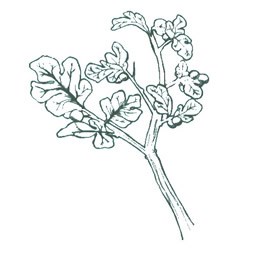
Anacardiaceae Lemonade Bush (Rhus trilobata) Usually less than two meters tall, this plant is found primarily in drainages and arroyos where water is more available. The berries can be used for making a tart, lemonade flavored tea. An important food source for desert animals.
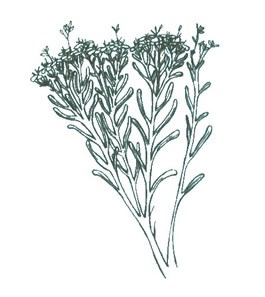
Asteraceae Snakeweed (Gutierriza spp.) A small shrub resembling Rabbitbrush. Native peoples use this as a treatment for snake bites, rheumatism and stomach disorders. It has spread throughout the west due to overgrazing. 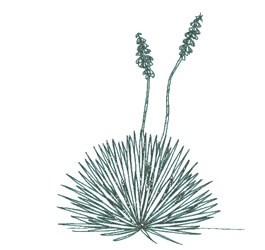
Agavaceae Soapweed Yucca (Yucca glauca) A low growing plant usually less than one meter tall, the yucca may flower many times during its life, but usually not every year. The baked fruits were a main staple for native peoples and are still eaten today to some extent. Thick leaves contain many thread or fibers which have a variety of uses. 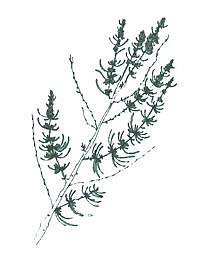
Asteraceae Sand Sage (Artemisia filifolia) An aromatic shrub similar to Big Sage, except its leaves are thin and thread-like. Growing up to one meter tall, it is an indicator of deep sandy soils. One of the most common shrubs within Petroglyph National Monument. 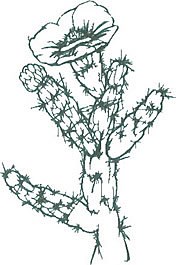
Cactaceae Cane Cholla (Opuntia imbricate) Normally about two meters tall, this cactus produces brilliant magenta colored flowers in the spring. Yellow colored fruits are often mistaken for flowers, and are an important food for desert creatures. 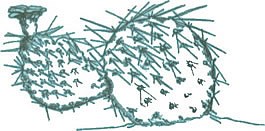
Cactaceae Plains Prickly Pear (Opuntia polyacantha) This low growing cactus has flat pads and spines. Pads are enlarged stems and spines are reduced leaves. Cacti are covered with a waxy coating which reduces water loss. The fruit of this plant resembles a dark-purple pear covered with small spines (hence the name). 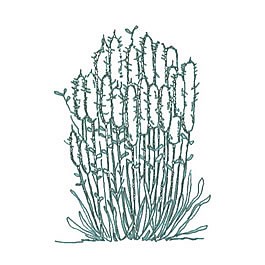
Chenopodiaceae Winterfat (Krascheninnikovia lanata) A small shrub usually less than a meter in height with stems rising from a central woody base. Distinguished by its “cottony” flowering clusters, it is a desired range plant due to its high nutritional value. 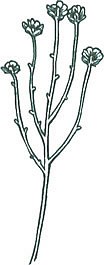
Fabaceae Broom Dalea (Psorothamnus scoparius) Less than one meter tall, this shrub has greenish-gray stems which carry on photosynthesis. Leaves are thin and thread-like. It typically blooms in mid-summer to early fall, but can also bloom in the spring if conditions are right. A deep indigo flower is produced at the end of each stem and is very aromatic. 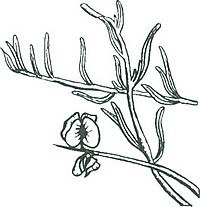
Chenopodiaceae Four-winged Saltbush (Atriplex canescens) Stiffly branched and 1-1.5 meters in height, this shrub is named for its winged fruits which are dispersed by the wind. A very hardy plant which can occupy almost any habitat from sea level to 7000 ft. elevations, it is nutritionally important to browsing animals. 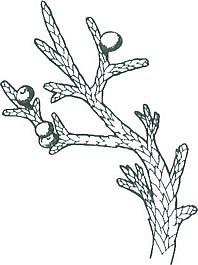
Cupressaceae One-seed Juniper (Juniperus monosperma) Considered a relic species from the Pleistocene period in the Southwest, the juniper appears out of place in modern deserts. Inhabiting shaded hillsides and arroyos where water is more available, its blue-gray “berries” are actually cones which are an important food source for desert creatures. 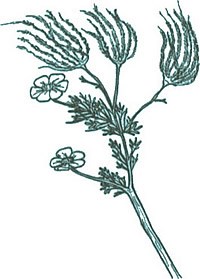
Rosaceae Apache Plume (Fallugia paradoxa) This one-meter tall shrub inhabits washes and drainages because of the availability of water in these areas. In full bloom, its brilliant white flowers contrast the dark foliage. The pistils of the flower ripen into delicate feathery plumes in the center of the flower. They are then dispersed by the wind.
Additional Sources Ivey, Robert Ivey. 1995. Flowering Plants of New Mexico, 3rd ed. Published by author. 504 pp. Martin, W.M. and C.R. Hutchins. 1984. Spring Wildflowers of New Mexico. University of New Mexico Press. 257 pp. Martin, W.M. and C.R. Hutchins. 1988. Fall Wildflowers of New Mexico. University of New Mexico Press. 294 pp. |
Last updated: January 31, 2018
